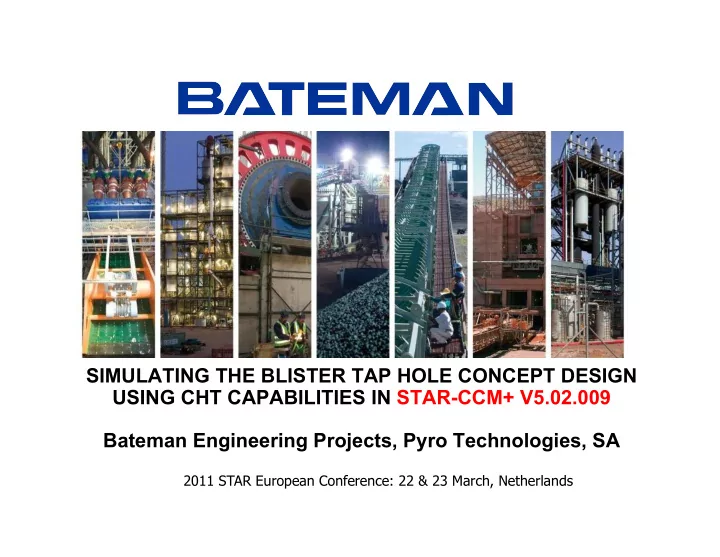

SIMULATING THE BLISTER TAP HOLE CONCEPT DESIGN USING CHT CAPABILITIES IN STAR-CCM+ V5.02.009 Bateman Engineering Projects, Pyro Technologies, SA 2011 STAR European Conference: 22 & 23 March, Netherlands
CONTENTS • Current Blister Tap Hole: • Numerical CFD Models (x4). • Conclusions. • Bull Nose Blister Tap Hole: • Numerical CFD Models (x3). • Conclusions. www.Bateman.com
Current SiC insert blister tap hole configuration (oxygen fuel burner effect included). 1. Steady state simulation – clay in tap hole with the Oxygen Fuel Burner (OFB) off. Results not shown. Aim: Establish the initial conditions for the subsequent transient runs. 2. Transient simulation – clay in tap hole with the OFB on (duration = 37 minutes). Determine the OFB heat flux required to incite the 6 thermocouple positions to correspond with the measured thermo- couple values (benchmark). 3. Transient simulation – blister flowing in tap hole with the OFB on (duration = 62 minutes). Simulate the transient tapping process to correspond with measured thermocouple values / trends. 4. Transient simulation – clay in tap hole with the OFB off (duration = 62 minutes). Simulate the cool-down cycle after transient tapping to correspond with measured thermocouple values / trends. www.Bateman.com
Current Blister Tap Hole – Thermocouple Positions www.Bateman.com
Clay in Tap Hole – Temperature (OFB on @ 34.8 kW/m ² ) T6 T5 T4 T2 T3 T1 www.Bateman.com
Clay in Tap Hole – Temperature (OFB on @ 34.8 kW/m ² ) www.Bateman.com
Blister in Tap Hole – Temperature (OFB on @ 34.8 kW/m ² ) www.Bateman.com
Blister in Tap Hole – Temperature (OFB on @ 34.8 kW/m ² ) www.Bateman.com
Clay in Tap Hole – Temperature (OFB off) www.Bateman.com
Clay in Tap Hole – Temperature (OFB off) www.Bateman.com
BTH7 – Summary of OFB on / OFB off conditions • Measured- & predicted CFD temperature values at the end of each transient cycle: Measured vs. T1 T2 T3 T4 T5 T6 Predicted [° C] [° C] [° C] [° C] [° C] [° C] T/C (clay & OFB on) 242.3 91.3 50.5 43.4 47.7 64.7 CFD (clay & OFB on) 242.5 142.0 98.9 81.2 78.4 89.8 T/C (blister & OFB on) 990.3 882.2 825.3 801.4 745.0 798.8 CFD (blister & OFB on) 961.7 911.3 963.9 971.1 906.3 923.8 T/C (clay & OFB off) 399.4 431.8 438.9 478.8 460.9 529.6 CFD (clay & OFB off) 355.7 389.8 426.5 446.0 451.8 463.9 www.Bateman.com
Current Blister Tap Hole – Conclusions • Differences in measured vs. predicted values attributed to: • Thermocouple positions & measurements maybe not exactly the same in the SiC insert (on-site vs. models). • Temperature CFD results are higher due to constant thermal material properties in all directions (isotropic). • Thermal resistances between region interfaces not incorporated in the numerical models (conjugate heat transfer). • However: Trends of graphs predicted more or less correctly for each transient stage. • Next step: Apply oxygen fuel burner boundary condition to the new bull nose blister tap hole concept. Predict thermal behaviour before actual installation earlier this year (March 2011). www.Bateman.com
Bull Nose High Alumina insert blister tap hole configuration (oxygen fuel burner effect included). 1. Steady state simulation – clay in tap hole with the OFB off (results not shown). Establish the initial conditions for the subsequent transient runs. 2. Transient simulation – blister flowing in tap hole with the OFB on (duration = 62 minutes). Simulate the transient tapping process to determine the increase in the maximum monitored SG Iron bull nose- & steel can temperatures. 3. Transient simulation – clay in tap hole with the OFB off (duration = 62 minutes). Simulate the cool-down cycle after transient tapping to determine the decrease in the maximum monitored SG Iron bull nose- & steel can temperatures. www.Bateman.com
Blister in Tap Hole – Temperature (OFB on @ 34.8 kW/m ² ) www.Bateman.com
Blister in Tap Hole – Temperature (OFB on @ 34.8 kW/m ² ) SG Iron Bull Nose Steel Frame & Can www.Bateman.com
Clay in the Tap Hole – Temperature (OFB off) www.Bateman.com
Clay in the Tap Hole – Temperature (OFB off) Steel Frame & Can SG Iron Bull Nose www.Bateman.com
BTH8 – Summary of OFB on / OFB off conditions • Predicted CFD temperature values at the end of each transient cycle: Maximum Temperatures for: SG Iron Steel Can High [° C] [° C] Alumina [° C] CFD (blister & OFB on) 483.5 386.1 1394.2 CFD (clay & OFB off) 242.2 362.4 502.8 www.Bateman.com
Bull Nose Blister Tap Hole – Conclusions • Maximum monitored temperature value in the SG Iron bull nose with the OFB on just short of 500 °C after an hour of blister tapping with constant heat flux = 34.8 kW/m ² on the front face. • Maximum monitored temperature value in the steel can hot face tapered tip just short of 390 °C after an hour of blister tapping (Thermal cycling / induced stresses not investigated). • Front of the High Alumina insert much hotter with the OFB on, albeit only locally around the tap hole exit. • All the regions monitored (SG Iron, Steel & High Alumina) heat-up during the tapping cycle within acceptable operating limits. • Cool-down cycle with the clay plug; after an hour the SG Iron cooled down to halve the maximum value when the OFB was on. The Steel Can cooled down by 24 °C, which is less sensitive to either tapping or plugged conditions. www.Bateman.com
QUESTIONS? www.Bateman.com
www.Bateman.com
Recommend
More recommend